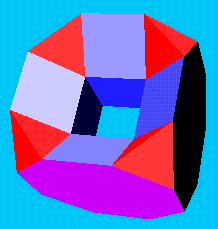Toroidal Polyhedra
 There
is a fascinating range of toroidal (donut-shaped) polyhedra that can be constructed
from regular polygons. A simple example, shown at right, is based
on the truncated cube, but drilled
out with a square hole:
You can put six square cupolas
and eight tetrahedra around a cube to make a truncated cube. This
is what remains if you remove two opposite cupolas and the inner cube.
There
is a fascinating range of toroidal (donut-shaped) polyhedra that can be constructed
from regular polygons. A simple example, shown at right, is based
on the truncated cube, but drilled
out with a square hole:
You can put six square cupolas
and eight tetrahedra around a cube to make a truncated cube. This
is what remains if you remove two opposite cupolas and the inner cube.
Based on the truncated cuboctahedron (and an inner, hollow rhombicuboctahedron) we can make tunnels to an inner region in three ways:
- torus 1 (through the octagons, i.e., removing square cupolas)
- torus 2 (through the hexagons, i.e., removing triangular cupolas)
- torus 3 (through the squares, i.e., removing cubes)
Two famous toroidal polyhedra (not made of regular polygons) are:
- The Csaszar polyhedron, which has 7 vertices and 14 triangular faces. Every pair of vertices is connected by one of its 21 edges. This polyhedron was described in a 1949 paper by Akos Csaszar.
- The Szilassi polyhedron, which has 14 vertices and 7 six-sided faces. Dual to the above, every pair of faces is adjacent. Discovered in 1977 by Lajos Szilassi, it was apparently first described in Martin Gardner's November 1978 Scientific American "Mathematical Recreations" column. (This VRML model was sent to me by Szilassi himself.)